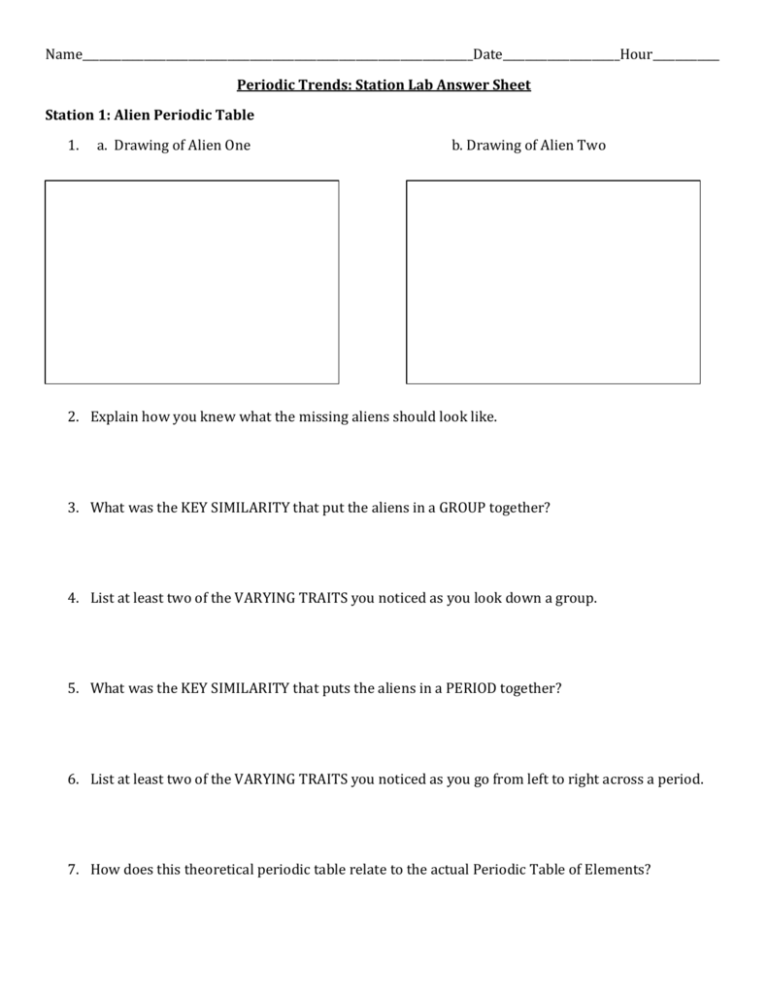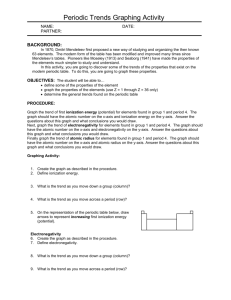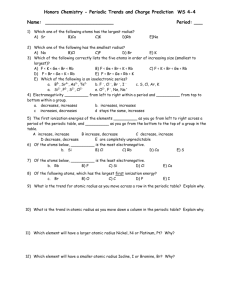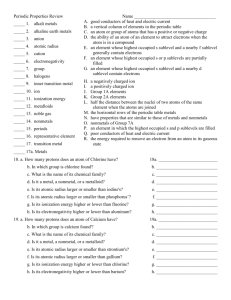File
advertisement

Name______________________________________________________________________Date_____________________Hour____________ Periodic Trends: Station Lab Answer Sheet Station 1: Alien Periodic Table 1. a. Drawing of Alien One b. Drawing of Alien Two 2. Explain how you knew what the missing aliens should look like. 3. What was the KEY SIMILARITY that put the aliens in a GROUP together? 4. List at least two of the VARYING TRAITS you noticed as you look down a group. 5. What was the KEY SIMILARITY that puts the aliens in a PERIOD together? 6. List at least two of the VARYING TRAITS you noticed as you go from left to right across a period. 7. How does this theoretical periodic table relate to the actual Periodic Table of Elements? Station 2: Coulombic Attraction Drawing of Description 1 Answer to Question 1 Answer to Question 2 Drawing of Description 2 Answer to Question 3 Station 3: Light My Fire, Flame Tests! NOTE: YOU MUST WEAR GOGGLES! Data Table Flame Tests: Sample Number Flame Color Observed Possible Ion Tested (You will answer this after stations 5 and 6) 1 2 3 4 5 6 7 1. Why did you need to put the ion from the solution into a flame in order to see the color? 2. When do you see a color from the flame-when the electrons are being promoted to higher energy levels or when they are coming back down? 3. Why do you think the flame test was unique for every element that you looked at? Station 4: The Color In Our Stars!! Emission Spectra Draw in the spectral lines below the colors you see using the colored pencils provided at this station (Indigo has been omitted due to the difficulty of distinguishing it from violet.) Element in Tube Observed Spectrum V B G Y O R Below you will see a star's spectrum. Your job is to identify all the elements you can detect in the star's atmosphere by comparing it to the individual spectra given to you at the station. Mystery Star Spectrum Elements Present 1. 2. 3. 4. 5. You have identified all the elements we can see in the star's spectrum. Real spectra are more complex, but now you have the basic idea. 1. Explain how astronomers use spectrographs to identify the composition of a star. Station 5: It’s Fourth of July in October, Fireworks! After watching the video at https://www.youtube.com/watch?v=nPHegSulI_M answer the following questions. 1. Look up the term “pyrotechnics.” What does this term mean? 2. What two things are necessary to produce a firework? 3. What is an aerial shell and describe how it works. 4. What color does each metal salt burn? Fill in the chart below as you watch the video. Metal Color Copper Strontium Sodium Calcium Barium Potassium Magnesium Station 6: More Chemistry and Fireworks! Questions: 1. What are the three types of energy released in a fireworks display? 2. Describe what happens to the atom when the metal salts used to make fireworks are heated. 3. Is light released when electrons move up to the excited state or when they move back down to the ground state? 4. Why do we see fireworks much sooner than we hear them? 5. What is an oxidizer? Describe the role oxidizers play in the detonation of fireworks. 6. List three safety regulations for large fireworks displays. 7. Where was gun-powder invented and who is credited for bringing it to Europe? 8. How are chemists trying to make fireworks more environmentally friendly? 9. Using the resources found in stations 5 and 6, go back and identify the metal ions you burned at the flame test station. Station 7: Graph Analysis (You will need a periodic table out in front of you to complete this station.) Graph 1: Atomic Radius 1. Define Atomic Radius: 2. Describe atomic radius in your own words. 3. Examine the graph carefully and describe the general trends in atomic radius. a. What happens to the atomic radius of an atom as you go across a period? Explain how you used the graph to figure this out. b. What happens to atomic radius of an atom as you go down a family? Explain how you used the graph to determine this answer. (You may want to connect elements in the same family with a trend line to see the relationship more clearly.) 4. Complete the following statements: a. As atomic number increases across a period, atomic radius ________________________. b. Explain why atoms get larger as you move down a family. 5. As atomic number increases down a family, atomic radius ________________________. a. Woah, wait! Can you make sense of this? How do you think this observation is atomically possible? Shouldn’t the atom get bigger if it’s gaining protons? Explain why atoms actually get smaller as you move across a period. Graph 2: Ionization Energy 6. Define ionization energy: 7. Describe ionization energy in your own words. 8. Examine the graph carefully and describe the general trends in ionization energy. a. What happens to ionization energy as you go across a period? Explain how you used the graph to determine this answer. b. What happens to ionization energy as you go down a family? Explain how you used the graph to determine this answer. (You may want to connect elements in the same family with a trend line to see the relationship more clearly.) Both Trends 9. Put the atomic radius graph on top of the ionization energy graph. Hold them up to the light so that you can see both at the same time. What do you notice about how they compare to each other? 10. Based on question 9, are atomic radius and ionization energy directly or indirectly related? 11. How might the radius (or size) of the atom affect the amount of energy needed to remove valence electrons? (Hint: Think about the attraction of the protons in the nucleus to the outermost electrons. Some atoms are larger than others, which would make the outermost electrons farther away from the nucleus that is holding them in place.) 12. There is one more trend that we will study, which is electronegativity. It follows the same trend as ionization energy. a. Define Electronegativity: b. What happens to electronegativity as to go across a period? c. What happens to electronegativity as you go down a family? d. Is electronegativity directly or inversely related to atomic radius? Explain. e. Predict and draw the graph you would see of Electronegativity vs. Atomic Number. In Summary: Atomic Radius: As you go across a period, atomic radius __________________________________. As you go down a family, atomic radius ___________________________________. Ionization Energy: As you go across a period, ionization energy __________________________________. As you go down a family, ionization energy ___________________________________. Electronegativity: As you go across a period, electronegativity__________________________________. As you go down a family, electronegativity ___________________________________. 13. Draw arrows on the periodic table below showing all three trends both across a period and down a family. (You may want to color code your arrows.)







